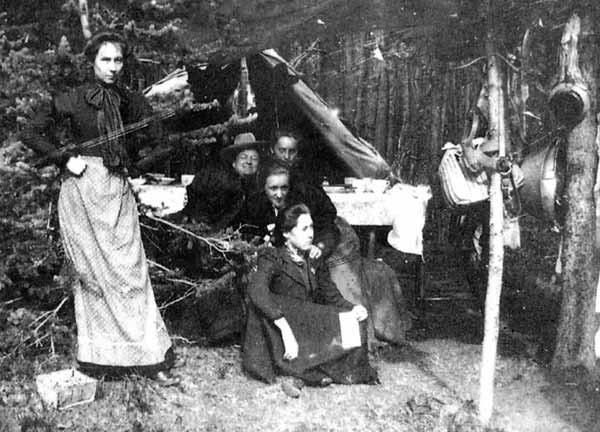
By M. Mark Miller
In 1913, Louise Elliott published a book about a young schoolteacher from Lander, Wyo., who took a job as a camp assistant for a mobile camp tour. In her preface, Elliott confesses that she used several techniques that critics now might label “new journalism.” She created composite characters by combining traits of her camp companions, and made up a “little romance” for her protagonist.
We can forgive Elliott because she provided an explicit disclaimer—and an entertaining portrait of travel to Yellowstone Park in the early 20th century. While her tales must be taken with the proverbial grain of salt, we probably can take her word that “the camp episodes and jokes, the weather and scenery, and the statistics” were all accurate descriptions copied from her diary.
Elliott gives interesting details of her trip: a cook who makes biscuits “charred on the outside and doughy in the middle,” a guide who carries “the scratchiest flannels” to be worn by anyone who didn’t heed his warning to bring warm clothing and snobbish hotel guests who refuse to return the greetings of lowly campers.
At one point during the story, Elliott says her protagonist, Violet, and her friend, Maud, became irritated with one of their guests—a Boston lady that they called “The Spinster.” Here’s Louise’s story about that.
Maud and I baked enough biscuits for supper and some cup cakes while the Spinster complained of all the discomforts of camp life as compared with her home conveniences. Neither did she forget to mention her lovely twenty-eight dollar and fifty-cent air mattress.
“That settles it once for all,” whispered Maud. “Never again!”
Well Maud had her revenge—and not once today has the Spinster boasted of her comfortable pneumatic mattress. I wondered last night why Maud was anxious to retire early as she is usually the last one to bed.
The great pine fire was lighting our tent, and the Spinster was peacefully enjoying her first snore when I saw our Irish lassie get stealthily out of bed—and crawl over to the hated mattress. She certainly must have made a thorough study of the mechanism—she knew just where to find the valve screw. She gave a few turns—crept back into bed again—and began breathing hard and steady.
Maud had not let me into her proposed vengeance because she feared I would not countenance it. But I suspected that the air was slowly leaking out of the mattress under the sleeping Bostonian. Soon that lady stopped her regular breathing and sat up in bed. She began fumbling under her and muttered, “Well, I never.” Finally she got up, punching the mattress, muttering something and reached into her bag.
Pump, pump, pump—I tried so hard to keep from giggling that a snort escaped from my throat. Maud began to talk incoherently and to toss and throw her arms about to cover my tell-tale noises. “No sir, I told you before that I will not dance—no—no—.” Then her voice died away and she snored vociferously while the—pump, pump, pump—continued. At last the wonderful pneumatic was restored to its proper stage of plumpness and the weary Spinster was soon resuming her snores where she left off.
She was more silent than usual this morning and did not allude in any way to her mattress. But while Maud and I were doing up the dishes, she went into the tent and gave her bed a thorough examination. She became more talkative after she had read the little pamphlet of directions, which had been attached to the mattress. After that she told the party how Maud had discussed her secrets and love affairs in her sleep.
Maud asked innocently, “What did I talk about?”
From L. Louise Elliott’s, Six Weeks on Horseback Through Yellowstone Park, 1913. For more stories about early visitors to Yellowstone National Park, see M. Mark Miller’s Adventures in Yellowstone: Early Travelers Tell Their Tales.


Great piece. But $28.50 for an air mattress in 1913? A small fortune.
Yes, Max. No doubt “the Spinster” was quite well-to-do.